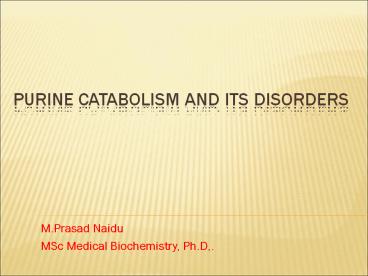Purine metabolism - PowerPoint PPT Presentation
Title:
Purine metabolism
Description:
BIOCHEMISTRY – PowerPoint PPT presentation
Number of Views:683
Title: Purine metabolism
1
Purine Catabolism and its disorders
- M.Prasad Naidu
- MSc Medical Biochemistry, Ph.D,.
2
Catabolism of purines
FAD, Molybdenum,iron
3
- The end product of purine catabolism is uric acid
- in humans.
- Uric acid is degraded into allantoic acid and
finally to ammonia in animals other than man. - Uric acid is 2,6,8 trioxy purine.
- It acts as antioxidant by converting itself into
allantoin.
4
- Uric acid
- Normal serum concentration 3 to 7 mg /dl in
males - 2
to 5 mg/dl in females - Miscible pool the quantity of uric acid present
in - body water. It is on
average of 1130mg - Daily turnover 500 to 600 mg synthesized
- 400 to 600 mg/day
excreted - Uric acid is cleared by both
- glomerular filtration
and - tubular secretion.
5
- Hyperuricemia and gout
- Hyperuricemia increased serum uric acid levels.
- Gout is a metabolic disorder of purine
catabolism, - resulting in overproduction of uric acid.
- At physiological pH , uric acid is more soluble
than urates.
6
(No Transcript)
7
- In hyperuricemia ,serum urate levels exceed
- solubility limit, leading to formation of
crystals and - get deposited in joints.The deposits are called
tophi. - Tophi cause inflammation of joints resulting in
painful - acute gouty arthritis, that can progress to
chronic - gouty arthritis leading to urolithiasis and renal
damage.
8
- Clinical features
- Manifestations are due to the low solubility of
uric acid in water. - Typical gouty arthritis affects first
- metatarsophalangeal joint.(GREAT TOE).
- Attacks are precipitated by alcohol intake.
- Often patient have few drinks , go to sleep
- symptomless , but are awakened during early
- hours by severe joint pains.
- Synovial fluid shows birefringent crystals under
polar microscope is diagnostic.
9
- Types of gout
- 1.Primary gout a) metabolic
b) renal - Metabolic Causes
- Abnormal enzyme - PRPP --- glutamylamidotransfe
rase is active but not sensitive to feedback
control. - Variant form of PRPP synthetase- not subject to
allosteric control. - Deficiency of enzymes of salvage pathway HGPRT
deficiency leading to Lesch-Nyhan syndrome. - b) Renal causes due to failure in uric acid
excretion.
10
2. Secondary gout a)Overproduction of uircacid
due to enhanced turn over rate of nucleic
acids i) Increased tissue turn over due to
psoriasis. ii) rapidly growing malignant
tissues-leukemias. ii)Increased tissue break down
after treatment for large tumour masses. (with
radiation,chemotherapy)
11
- b)Reduced excretion of uric acid
- Increased alcohol consumption leads to lactic
-acidosis. Lactic acid inhibits uric acid
excretion. - Thiazide diuretics inhibits tubular secretion of
uric acid. - Renal failure.
- c) OTHERS
- VONGIERKES DISEASE
- Elevated glutathione reductase
12
- Treatment
- Low intake of purine diet
- Restrict alcohol
- Drugs
- 1.uricosuric drugs probenecid,salicylates,hal
ofenate - 2. enzyme inhibitors allopurinol
13
Action of allopurinol Allopurinol
alloxanthine
xanthine oxidase
inhibits Xanthine and hypoxanthine are more
soluble and excreted easily.
14
- Palliative treatment
- Anti-inflammatory drugs
- Colchicine is used .
- Others include indomethacin , ibuprofen.
- Steroids also used.
15
Lesch-Nyhan syndrome Inheritance pattern --
X-linked recessive Enzyme defect(salvage pathway)
-- hypoxanthine guanine phoshoribosyl
transferase (HGPRT) Rate of salvage pathway
decreases Accumulation of intracellular PRPP and
decrease in GMP and IMP ,the inhibitory
nucleotides Increased production and degradation
of purine nucleotides.
16
- Features
- Only males are affected, as structural gene for
HGPRT is on X- chromosome. - Characterised by excess formation of uric acid.
- Nephrolithiasis
- Selfmutilation
- Neurological abnormalities like mental
-retardation, aggressive behavior , learning
disabilities occur. - Neurological symptoms may be due to dependence
of brain on the salvage pathway.
17
Adenosine deaminase deficiency and purine-
nucleoside phosphorylase deficeincy Both are
Inherited as autosomal recessive.
Deficeincy ADA purine
nucleoside phosphorylase Both T and
T-cells affected , B-cells affected.
B -cells are normal.
18
- Immune dysfunction appear to result from
- accumulation of dGTP and dATP
- .
- These allosterically inhibits ribonucleotide-
- reductase,thereby depletes cells of DNA
- precursors, particularly dCTP.
- HYPOURICEMIA.
19
VONGIERKES DISEASE
Glucose-6-phophatase
20
- Pseudogout
- Serum uric acid level normal.
- Symptoms as seen in gout.
- But it is characterised by deposition of calcium
- pyrophosphate crystals.
21
- Hypouricemia
- Xanthine oxidase deficiency, either genetic or
due to - severe liver damage.
- Patients exhibit xanthinuria and xanthine
lithiasis.
22
Thank you































